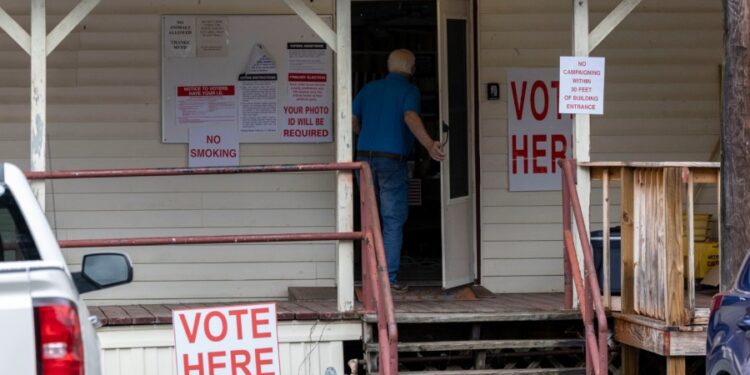
With three weeks until Election Day, Vice President Kamala Harris leads in almost all reputable national polls, including eight of the last 10 national polls aggregated by RealClearPolitics.
That said, national polls obscure the true state of the race, which appears to be a statistical tie, perhaps even leaning in Trump’s direction.
Indeed, the Cook Political Report survey shows Harris leading in Michigan (+3), Wisconsin (+2), Arizona (+2), Nevada (+1) and Pennsylvania (+1), with North Carolina being a tie, and Trump up by 2 points in Georgia.
And yet, RealClearPolling’s aggregated swing state polls tell virtually the opposite story. Here, Trump leads in six of seven swing states, with Harris leading in Wisconsin.
Critically, the only thing consistent in both the Cook survey and the polling aggregate is that in no state does either candidate have a lead greater than the margin of error, further highlighting the tightness of the race.
Aside from the fact that Trump’s support is almost certainly being under-counted in the polls, there are quantitative reasons why, particularly in the swing states, Trump is likely stronger than he appears.
Put another way, below the topline numbers, polling suggests that momentum appears to be shifting to Trump.
Political betting markets, which can react to events quicker than polls, give Trump an average 54 percent chance to win, with Harris currently at 45 percent.
Further, as Election Day approaches, voters tend to choose the candidate they feel will be best able to handle the issues that matter to them. According to Reuters polling, more than 4 in 10 (42 percent) registered voters DFsaid the economy (26 percent) and immigration (16 percent) were the most important issues facing the country today.
Similarly, within the swing states, the economy (28 percent) and immigration (21 percent) were the two most important issues to voters, per Wall Street Journal swing state polling.
These two issues also happen to be where Trump is strongest against Harris, particularly among swing state voters.
By sizable margins, swing state voters feel that Trump — rather than Harris — is most able to handle immigration (52 percent to 36 percent), inflation (50 percent to 39 percent), as well as the economy (50 percent to 40 percent), according to the Wall Street Journal.
Trump has made these issues a centerpiece of his campaign, and will certainly do so in the campaign’s final weeks, likely to his benefit.
In that same vein, polls underscore the problems Democrats are facing in the absence of a communications strategy to outline Harris’s plans to address the issues voters consistently say they care about.
Asked if they think Trump and Harris have “clearly explained their policies and plans” on various issues, majorities of voters say Trump has clearly explained his plans for illegal immigration (69 percent), and strengthening the economy (51 percent), per Pew Research.
Conversely, strong majorities of voters say Harris has not clearly explained her plans to address illegal immigration (69 percent), foreign policy (62 percent) or to strengthen the economy (56 percent).
Simply, voters know — and tend to support — Trump’s approach to these critical issues, whereas majorities do not even know where Harris stands. As the polls below show, this is already hindering Harris with Independents in a few critical states.
To that end, there are evident shifts among key demographic groups as well which underscore the change in momentum, even if the topline numbers do not make it obvious.
Among Hispanic voters — a critical voting bloc for Democrats — a majority (52 percent) support Trump, compared to 44 percent for Harris, per Quinnipiac polling. If this bears out, it would be a historic shift from 2020, when Biden won roughly two-thirds (65 percent) of the Hispanic vote, according to CNN exit polls (link).
If this holds, Harris would be at a considerable disadvantage in Arizona and Nevada.
Further, Harris is underperforming Biden with union households in Michigan and Pennsylvania, two critical states. Biden won this group by 25 points four years ago, yet Harris leads Trump by just 10 points, per Hill/Emerson polling.
Pennsylvania voters in union households, which Trump won by 2 points in 2020 now support the former president 53 percent to 43 percent, a not insignificant shift.
Harris is also underperforming Biden with independents, particularly in the “Blue Wall” states of Michigan and Wisconsin.
In 2020, Biden won Michigan Independents by 6 points, yet this group now backs Trump by 10 points (52 percent to 42 percent). And in Wisconsin, Harris’s 3-point lead with independents is considerably lower than the 12-point margin Biden had.
For her part, Harris is outperforming Biden among college-educated white voters and white women.
The largest swing in Harris’s favor is white voters with a college degree, 60 percent of whom back Harris, per New York Times-Siena polling, a 9-point improvement from Biden’s 2020 numbers.
Harris has also brought white women — who backed Trump 55 percent to 44 percent in 2020 — into the fold, as a majority (52 percent) now support her according to the aforementioned Quinnipiac poll.
Yet Trump’s sizable lead on the key issues, particularly with swing state voters, may prove to have the most impact.
Ultimately, with three weeks left before the election, the polls reflect one fundamental point: This race will be extremely close.
At the same time, they also make it clear that, in the campaign’s final days, Trump is leading where it counts, namely on the issues that determine whom voters support.
Douglas E. Schoen is a political consultant and the founder and partner at Schoen Cooperman Research. His latest book is “The End of Democracy? Russia and China on the Rise and America in Retreat.”







